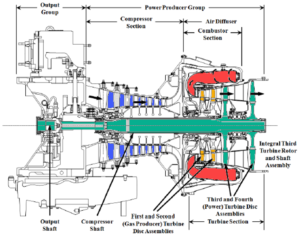Cogeneration is an attractive energy producing alternative to grid power when the facility also requires heat for the process being performed. Using gas turbines as the prime mover to generate electrical power provides opportunities for improving energy utilization, efficiency, reliability, and in many cases, process operations using the exhaust heat of the gas turbine.

Recovering Useful Heat
Over two-thirds of a gas turbine generator's energy content is converted to waste heat. By recovering the heat for productive use in other processes, efficiencies are improved from nearly 30 percent to over 80 percent, depending on the application. Furthermore, the recovered heat is often better than free when heat recovery equipment displaces a boiler or other heating source, resulting in a net reduction in fuel expenses and emissions.
The objectives of installing a cogeneration plant are to meet both an electrical power demand and a prescribed heat load. Typically, the facility heat load is the most critical parameter to match despite the obvious task of generating electricity. Since heat load must be satisfied using a constant stream of exhaust gas, a thorough understanding of the heating load profile and the ability to match the heat load at any given time are critical.
Variations in heat load are accommodated through an exhaust bypass for low load factors and supplemental firing for high load factors. Alternatively, the electrical demand can be easily supplemented by the utility company during power shortfalls or resold to the utility company during low electrical demand. Economics favor systems that operate at least 8,000 hours per year and that have sufficient and constant heat loads.
Cogeneration Advantages
Power reliability: Onsite cogeneration systems equipped with sufficient redundancy such as standby grid connection and Uninterruptible Power Supply (UPS) systems can far exceed the reliability of some local utilities.
Power quality: Gas turbine generators typically provide constant voltages and currents without the external peaks and interruptions that are often found on the grid.
Reduced emissions: Compared to supplying heat and power loads separately, cogeneration offsets other forms of energy production such as power grid generation and localized firing of natural gas or diesel in a boiler for steam production.
System Alternatives
The application of cogeneration to various processes is boundless. As long as a significant heat sink is available, economics and imagination are the only limiting factors. Some examples include:
- Mix air with gas turbine exhaust as a means to direct dry various products.
- Direct the gas turbine exhaust into an indirect-fired absorption chiller to produce chilled water.
- Heat or vaporize heat transfer fluids other than water for chemical process applications.
- Apply cogeneration to a large scale building energy plants where power, steam, hot water, and chilled water are produced from a single fuel source.
- Connect a backpressure steam turbine with an overriding clutch to the free end of the generator in a gas turbine generator package.
Cogeneration has potential in almost every industrial and commercial setting. By evaluating the power and heat costs paid over the life cycle of a plant, it becomes obvious that the economic and operational benefits far outweigh the effort of developing and maintaining a cogeneration plant.

